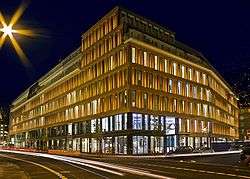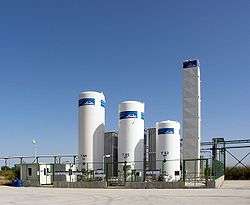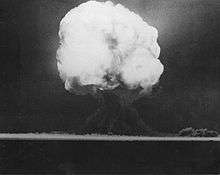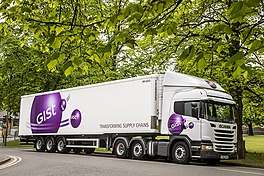Linde plc
Linde plc is an American-German, Irish-domiciled multinational chemical company formed by the merger of Linde AG of Germany (founded in 1879) and Praxair (founded in 1907 as Linde Air Products Company) of the United States. It is the world's largest industrial gas company by market share as well as revenue. Linde shares are traded in Germany and the United States, and included in those countries' DAX 30 and S&P 500 major stock market indices.
 | |
 | |
| Public limited company | |
| Traded as | |
| ISIN | IE00BZ12WP82 |
| Industry | Chemicals |
| Founded | 1879 |
| Founder | Carl von Linde |
| Headquarters | Guildford, Surrey[1] , United Kingdom (Holding company) |
Key people | Steve Angel (Chief Executive Officer), Wolfgang Reitzle (Chairman of the Board) |
| Products | Industrial gas production, medical gas and air separation plant engineering, logistics services |
| Revenue | |
| Total assets | |
| Total equity | |
Number of employees | |
| Website | www.lindeplc.com |

The Linde Group has over 600 affiliated companies in more than 100 countries,[4] with customers in the industrial, retail, trade, science, research, and public sectors.
In September 2006 the company acquired its UK based competitor The BOC Group, and subsequently disposed of its non-gas interests. Linde's former materials handling business was rebranded as KION Group in September 2006 and sold in November 2006 to KKR and Goldman Sachs for €4bn. In March 2007 the BOC Edwards semiconductor equipment business was sold to CCMP Capital for €685m.[5]
Linde's revenue in 2016 were €16.948 billion, with 59,715 employees.[3]
Following the BOC acquisition, The Linde Group has become the world's largest industrial gas company. In 2005, Linde AG and BOC together had 21% of the world's market in industrial gases followed by Air Liquide with 19%, Praxair with 13%, Air Products & Chemicals with 10%, Taiyo Nippon Sanso Corporation with 4%, Airgas with 3% and Messer Group with 1%.[6]
Business activities
The Linde Group today has two principal business areas: gas (industrial gases and medical gases), and engineering. In the industrial gas area the group trades under a number of established brand names including Linde, AGA, BOC, TIG, MOX, Afrox and PanGas. HiQ is used as an identifier for high purity and premium specialty gases across all of these business brand names. In the medical gas area, Linde is known with the following names, Linde Gas Therapeutics, AGA Medical, INO Therapeutics, Linde Homecare, Farmadomo and Life Gas.
- Linde Gas supplies industrial gases, medical gases, specialty gases, refrigerants and other chemicals. Depending on the gas and the quantity required, these may be supplied in portable high-pressure gas cylinders, in liquefied form by road tanker, from on-site gas generators or in gaseous form via pipeline to large customers.
- Linde Engineering designs and builds large-scale chemical plants for the production of industrial gases including oxygen, nitrogen, argon, hydrogen and carbon monoxide, as well as large plants associated with the processing of natural gas, LNG, LPG and the manufacture of olefins.
History

On 21 June 1879, Carl von Linde founded the Gesellschaft für Linde's Eismaschinen Aktiengesellschaft to develop further his work in developing mechanical refrigeration systems for the brewing and food industries. Following success in this market, he moved on to developing lower temperature systems resulting in 1895 in a patent covering the liquefaction of air. Out of this work his company developed equipment for the separation of air and other gases. Linde's process was patented in 1902 and immediately exploited by the first large-scale air separation plant installed in Linde's work in Höllriegelskreuth, near Munich in 1903.[8]:67 In 1906, Carl Von Linde decided to expand his oxygen extraction company oversees, targeting America, where no other companies had attempted industrial scale oxygen extraction. He opened his first plant in America at Buffalo, New York in 1907, known as the Linde Air Products Factory.[10]
In addition to plants for air separation, in 1906 Linde engineers started working with others on processes to separate the constituents of water gas. This work developed into capabilities in the recovery of hydrogen and carbon monoxide, which were further key feedstocks for the emerging chemicals industry.
In addition to his interests in refrigeration, Carl von Linde had also partnered with Hugo Güldner and Georg von Krauß and others in 1904 to form the Güldner Motoren-Gesellschaft mbH in Munich, which was moved to Aschaffenburg in 1906. Linde took full ownership of the company in 1929, and from this origin developed a business manufacturing first engines and tractors, and then from the 1950s onwards, a range of mechanical handling equipment such as fork lift trucks. Linde also acquired the Aktiengesellschaft für Industriegasverwertung (english: Corporation for Industry Gas Utilization ), commonly referred to as the Heylandt Works.
In the years of Nazi Germany, Linde AG benefited from the country's attempt to become self-sufficient by refraining from imports of synthetic petrol and rubber. In 1935 general manager Friedrich Linde received the title of Wehrwirtschaftsführer, which on the one hand underlined the national importance of Linde AG and on the other hand allowed the company to further benefit from the enlarged armament program.[8]:99 Among the closest colleagues of the general director was Dr. Alfred Hess, plant manager in Höllriegelskreuth and uncle of Deputy Führer of the Nazi Party Rudolf Hess.[8]:100
Before and during World War II, all departments of Linde AG were in some way involved in the armaments production: The Heylandt-Gesellschaft für Apparatebau supplied the German rocket program, other branches produced welding equipment and engines for the armaments industry.[8]:111 In 1941 Linde manufactured oxygen and helium installations for IG Farben at the Auschwitz concentration camp. Three further planned installations were not installed due to the course of war.[8]:113-114 According to estimates of the company for mid-1944, between 400 and 500 people were used as forced labourers in production plants.[8]:115
Linde Air Products, since 1917 part of the Union Carbide & Carbon Corporation sued another company in 1950 for violating their patent on a welding process by simply substituting a similar material. In Graver Tank & Manufacturing Co. v. Linde Air Products Co., the United States Supreme Court established the doctrine of equivalents which found that, while not in the literal scope of the patent, the concept discovered by Linde was still being unfairly encroached upon without compensation.[11]
A complex history of takeovers, mergers and divestments occurred, and in 2000 completed the acquisition of AGA AB of Sweden. This was followed in 2004 with the divestment of the original core of the Linde business – the refrigeration division – to Carrier Corporation of the USA.[12] In March 2006, Linde made a proposal to acquire The BOC Group for €11.7 billion in cash.[13] The acquisition was completed on 5 September 2006.[14] Following the acquisition, the combined gas and engineering group was rebranded as The Linde Group, and the materials handling activities separated and rebranded as KION Group. It was also announced that the BOC Edwards equipment business was to be sold.[15]
In 2008, the head office of Linde AG was relocated from its historic headquarters in Wiesbaden to Munich; the new company headquarters are located in the Angerhof building in downtown Munich; the Group's new name is The Linde Group.[16]
In 2010 the group acquired over 95% of the shares of Sri Lanka based, Ceylon Oxygen Ltd.[17]
In June 2011, PT Linde Indonesia, a subsidiary of the Linde group, announced its plan to build an air separation plant worth Rp.1 trillion ($117.33 million) in Cilegon, Banten, to supply industrial gas to PT Krakatau Posco's steel plant.[18]
In January 2012, the company acquired the Continental-European homecare business of the industrial gases company Air Products at an enterprise value of €590 million.[19] This business achieved annual sales of €210 million in 2011.[20] The transaction comprises Air Products' homecare operations in Belgium, France, Germany, Portugal and Spain with around 850 employees. In August 2012, the company acquired Lincare Holdings Inc., a healthcare gas provider in the USA for US$4.6 billion.[21] Lincare Holdings had sales of US$1.8 billion in 2011. In August, the Linde Group completed the acquisition and became the largest home care gas supplier in North America.[21] In December, the company acquired homecare company Calea France SAS.[22]
In February 2016, Lincare Holdings acquired American HomePatient, Inc.[23] In December, Linde Korea completed the acquisition of Air Liquide Korea's industrial merchant & electronics and liquid bulk air gases divisions, based in South Korea.[24]
On August 9, 2019 Linde has partnered with CarbonCure Technologies.[25]
Praxair merger
In August 2016 it was publicly announced that the German company was in official negotiations to merge with the American competitor Praxair, which would form the world's largest gas supplier.[26][27][28][29] The following month in September the negotiations were halted and suspended indefinitely.[30][31][32][33] As of mid December 2016 Praxair resumed negotiations with Linde for a potential merger.[34][35][36][37][38] In late December an official announcement was made that Praxair had reached an agreement to merge with Linde in a deal valued at $35 billion and[39] with an overall merger value of $65 billion.[40] In April 2017 Linde again rejected a request for a shareholder vote at its annual general meeting in May – this is the second time the company has rejected Praxair's request.[40] In May 2017, both companies reached a deal in principle on an all-share merger of equals valued at $75 billion,[41] the deal will still need the approval of Praxair's board of directors as well as Linde's management and executive boards[42] and if approved, will form a new holding company.[43] In early June 2017, both companies agreed to the merger.[44]
On October 31, 2018 the Company declared that business combination between Praxair and Linde AG had been successfully completed except finalising divestitures required by the respective antitrust authorities.[45]
On March 1, 2019 the Company declared it completed divestitures required by US antitrust authorities and will now fully integrate its business globally.[46]
 Linde Gas Schiedam Storage
Linde Gas Schiedam Storage- Tank for liquid hydrogen of Linde, Museum Autovision, Altlußheim
- trailH2
 Linde E20
Linde E20- Linde air separation plant in Washington, West Virginia
Financial data
| Year | 2013 | 2014 | 2015 | 2016 | 2017 |
|---|---|---|---|---|---|
| Revenue | 16.655 | 17.047 | 17.944 | 16.948 | 17.113 |
| Net Income | 1.430 | 1.162 | 1.252 | 1.327 | 1.536 |
| Assets | 32.749 | 34.425 | 35.347 | 35.189 | 33.513 |
| Employees | 63,487 | 65,591 | 64,538 | 59,715 | 57,605 |
Operations
Subgroups and service companies
Linde AG comprises three subgroups. The largest division, Gases, has four operating segments, Western Europe, the Americas, Asia & Eastern Europe, and South Pacific & Africa. These segments are subdivided into eight Regional Business Units (RBUs).
The Gases Division also includes the two Global Business Units (GBUs) – Healthcare (medical gases) and Tonnage (on-site) – and the two Business Areas (BAs) – Merchant & Packaged Gases (liquefied and cylinder gases) and Electronics (electronic gases).
Industrial Gases and Health Care
Linde Industrial Gases produces and distributes the atmospheric gases oxygen, nitrogen and argon, all of which are manufactured in Linde's air separation plants.
The product range includes hydrogen, acetylene, carbon monoxide, carbon dioxide, shielding gases for welding applications, noble gases and specialty gases.
Linde Healthcare provides pharmaceutical and medical gas products and services for healthcare professionals.
Linde Healthcare is present in 70 countries. Pharmaceutical and medical gases are used in the diagnosis or treatment of a number of clinical conditions. In addition to oxygen therapy, aerosol therapy and anaesthesia, Linde Healthcare provides medical gas for chronic obstructive pulmonary disease, asthma, sleep apnoea and pain.
Linde Engineering
The Engineering Division develops process plants in the engineering, procurement and construction (EPC) business worldwide. Linde Engineering focus on market segments such as plants for the production of hydrogen and synthesis gas, oxygen and olefins as well as plants for natural gas treatment.
The group has more than 1,000 process engineering patents and 4,000 completed plant projects. [48]
The product range includes:
- Air separation plants
- Ethylene Cracker Units
- Lng and natural gas processing plants
- Hydrogen and synthesis gas plants
- Chemical and petrochemical plants
- Adsorption plants
- Cryogenic plants
- CCS and CO2 plants
- Furnaces, incinerators and heaters
- Plant components[49]
Gist Limited

Gist Limited, headquartered at Chineham Business Park, Basingstoke, offers supply chain services including end-to-end management and customer fulfilment through transport and warehousing. The company employs approximately 5,000 people in 40 locations in Great Britain, France, Czech Republic, the Netherlands, and the USA, with customers including Marks & Spencer, Waitrose & Partners, Tesco, Starbucks, Morrisons[50], EAT, Young's Seafood[51] and Arla Foods.[52]
Gist also manages Global Freight movements across the world for a variety of clients, including Intergreen and Manchester Tank.
Gist Limited's UK operations reported an annual revenue of £437m in December 2017.[53]
In partnership with Brake, Gist's Child Road Safety scheme, established in 2011, has seen more than 120,000 safety sessions delivered to children across the UK, warning of the dangers of HGVs on the road.[54]
The history of Gist Limited dates back as far as 1920, when George Littmoden began moving fruit and vegetables to Covent Garden market by horse and cart. George's business, called GL Baker, began transporting fresh fruit for Marks & Spencer in 1932. In 1969, BOC acquired GL Baker, after it expressed interest in its use of liquid nitrogen in chilled containers. The new company was titled BOC Transhield. The new company consisted of 1,100 employees, operating from five locations across the UK. The company was renamed BOC Distribution Services in 1991, before being rebranded as Gist Limited (Gist being the 'heart of logistics') and moving its headquarters to Chineham in 2001.[55]
After The Linde Group took over BOC in 2006[56], it also acquired Gist. Following the group's merger with Praxair to form Linde plc, Gist continues to operate as a separate entity under Linde.[57]
See also
References
- https://www.sec.gov/cgi-bin/browse-edgar?CIK=LIN&action=getcompany
- "Annual Report 2018" (PDF). Linde. Archived (PDF) from the original on 10 September 2016. Retrieved 25 July 2019.
- "Annual Report 2016" (PDF). Linde. Archived (PDF) from the original on 24 January 2018. Retrieved 9 March 2017.
- "The Linde Group – Gases Engineering Healthcare -". resources.linde.com.
- "Ad hoc: Linde sells component business of BOC Edwards to CCMP Capital – News and Events > Adhoc News – Linde AG". Archived from the original on 27 September 2007.
- Linde Conference Presentation, January 2007 Archived 26 September 2007 at the Wayback Machine
- "Linde Air Products". National Institute for Occupational Safety and Health. 31 March 2011. Archived from the original on 24 September 2015.
- Dienel, Hans-Liudger (2004). Linde. History of a Technology Corporation, 1879-2004. Palgrave Macmillan. ISBN 978-0-230-50953-5.
- Blumenthal, Ralph (1 February 1981). "Big Atom Waste Site Reported Found Near Buffalo". The New York Times. Archived from the original on 4 March 2017.
- "Cultural Resource Information System (CRIS)" (Searchable database). New York State Office of Parks, Recreation and Historic Preservation. Retrieved 5 October 2019. Note: This includes M. Shoen; D. King; K. Hoke; M. Arch; C. Moriarty & Jennifer Walkowski (April 2017). "National Register of Historic Places Registration Form: Linde Air Products Factory" (PDF). Retrieved 6 October 2019. and Accompanying photographs
- Jackson, Robert H. (29 May 1950). "GRAVER TANK & MFG. CO., Inc., et al. v. LINDE AIR PRODUCTS CO". Legal Information Institute. Archived from the original on 8 March 2014. Retrieved 10 July 2013.
- "Linde Corporate Heritage". linde.com. Archived from the original on 20 March 2006.
- BBC Archived 4 September 2007 at the Wayback Machine, 6 March 2006
- "Linde Corporate Homepage". Archived from the original on 5 February 2012.
- "Linde Corporate Website". linde.com. Archived from the original on 7 September 2006.
- "Für Linde liegt die Zukunft in München" (in German). Handelsblatt. 10 October 2006. Retrieved 4 June 2019.
- "The Linde Group acquires majority stake in Ceylon Oxygen Limited & Media > Pressemitteilungen – Linde Industrial Gases". Archived from the original on 20 July 2017.
- Post, The Jakarta. "Linde Indonesia to build Rp 1 trillion air separation plant". The Jakarta Post. Archived from the original on 12 June 2011.
- "Archived copy" (PDF). Archived (PDF) from the original on 8 April 2018. Retrieved 24 May 2017.CS1 maint: archived copy as title (link)
- "Case search – Competition". European Commission.
- "Subscribe to read". Financial Times. Archived from the original on 9 April 2018.
- "Linde acquires homecare company Calea France SAS & Media > Press Releases -". Archived from the original on 18 June 2017.
- "Lincare, a Linde subsidiary, closes acquisition of American HomePatient – The Linde Group". Archived from the original on 2 July 2017.
- "Linde Korea completes acquisition of Air Liquide Korea's industrial merchant and electronics on-site and liquid bulk air gases business in South Korea – The Linde Group". Archived from the original on 2 July 2017.
- "Linde partners with CarbonCure to bring CO2 utilisation to Europe and Asia-Pacific". GasWorld.com. Retrieved 12 August 2019.
- Fontanella-Khan, James; Massoudi, Arash (16 August 2016). "Praxair makes move for German rival Linde". Financial Times. Archived from the original on 19 August 2016. Retrieved 23 August 2016.
- Iwasaki, Mariko (16 August 2016). "Praxair in Talks to Acquire Germany's Linde". TheStreet. Archived from the original on 17 August 2016. Retrieved 23 August 2016.
- Stone, Mike; Hack, Jens (16 August 2016). "UPDATE 3-Gas supplier Praxair opens talks to buy Germay's [sic] Linde". CNBC. Archived from the original on 13 September 2016. Retrieved 16 August 2016.
- Stone, Mike; Hack, Jens (16 August 2016). "Gas suppliers Praxair, Linde hold merger talks". Reuters. Archived from the original on 17 August 2016. Retrieved 16 August 2016.
- Henning, Eyk. "Praxair, Linde call a halt to merger talks". marketwatch.com. Archived from the original on 30 August 2017.
- "Subscribe to read". Financial Times. Archived from the original on 18 November 2016.
- Henning, Eyk (12 September 2016). "Praxair and Linde Call Off $60 Billion Merger Talks". The Wall Street Journal. Archived from the original on 24 July 2017.
- "Linde, Praxair end $60 billion merger talks". Reuters. 12 September 2017. Archived from the original on 30 August 2017.
- Henning, Eyk (7 December 2016). "Linde Resumes Merger Talks With Praxair". The Wall Street Journal. Archived from the original on 17 May 2017.
- Vielma, Antonio José (29 November 2016). "Praxair reapproaches Linde to resume merger talks: Report". CNBC. Archived from the original on 30 August 2017.
- "Linde CEO Resigns, Praxair Talks to Resume". global.handelsblatt.com. 7 December 2016. Archived from the original on 20 December 2016.
- Bray, Chad (7 December 2016). "Linde of Germany to Resume Merger Talks With Praxair". The New York Times. Archived from the original on 18 December 2016.
- "Linde Accepts Praxair's Offer to Resume Merger Talks". mdm.com. Archived from the original on 20 December 2016.
- "Praxair to Buy Linde for $35 Billion in Industrial-Gas Deal". Bloomberg L.P. 20 December 2016. Archived from the original on 5 June 2017.
- Editorial, Reuters. "Linde rejects request to vote on Praxair merger at AGM". Archived from the original on 16 April 2017.
- Prodhan, Georgina. "Linde turns to winning over investors to Praxair merger". Reuters. Archived from the original on 2 June 2017.
- Editorial, Reuters. "Linde, Praxair reach agreement on details of merger". Reuters. Archived from the original on 24 May 2017.
- "Potential Merger – The Linde Group". Archived from the original on 19 May 2017.
- Prodhan, Georgina. "Linde, Praxair agree $73 billion merger to create global gases leader". Reuters. Archived from the original on 3 June 2017.
- "Business Combination Between Praxair and Linde AG Successfully Completed". linde.com. Retrieved 16 April 2019.
- "Linde plc Completes Required Divestitures, Hold Separate Order Restrictions Lifted". linde.com. Retrieved 16 April 2019.
- "Linde Bilanz, Gewinn und Umsatz | Linde Geschäftsbericht | 648300". wallstreet-online.de. Retrieved 5 November 2018.
- "Archived copy". Archived from the original on 24 May 2016. Retrieved 6 June 2016.CS1 maint: archived copy as title (link). Retrieved 6 June 2016
- "Archived copy". Archived from the original on 5 June 2016. Retrieved 6 June 2016.CS1 maint: archived copy as title (link). Retrieved 6 June 2016
- "News - GIST LIMITED". www.gistworld.com. Retrieved 11 October 2018.
- "Gist expands supply chain partnership with Young's Seafood - GIST LIMITED". www.gistworld.com. Retrieved 11 October 2018.
- "Gist's new contract with Arla Foods UK in Northern England and Scotland - GIST LIMITED". www.gistworld.com. Retrieved 11 October 2018.
- "DueDil". www.duedil.com. Retrieved 21 November 2018.
- "Child Road Safety Programme | Gist Limited". www.gistworld.com. Retrieved 5 March 2019.
- "Our History | Gist Limited". www.gistworld.com. Retrieved 5 March 2019.
- Gow, David (6 March 2006). "Germany's Linde acquires BOC to create world's biggest gases group". The Guardian. ISSN 0261-3077. Retrieved 5 March 2019.
- "Linde abandons plans to sell Gist". Logistics Manager Magazine. 25 July 2018. Retrieved 5 March 2019.
External links
- Business data for Linde plc: